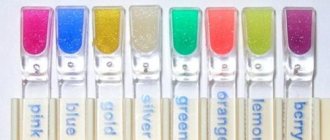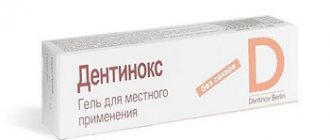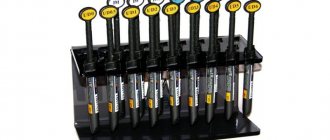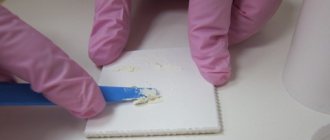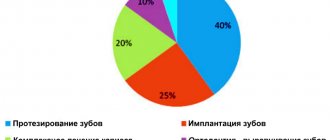Unitem is a two-component, three-color zinc phosphate dental cement.
Dental cement Unicem is available in three colors (white, light yellow, golden yellow) or bactericidal, containing the optimal amount of a bacteriostatically effective form of silver.
Zinc phosphate cement Unitsem three-color is used for fixing inlays, pin teeth, metal, plastic, porcelain, metal-ceramic crowns and bridges, for filling teeth to be covered with crowns, as an insulating spacer (for example, Ionosit) when filling teeth with amalgams, silicate and silicophosphate cements .
Unicem bactericidal is used in pediatric dentistry for filling baby teeth.
Properties
Unicem is a universal, improved zinc phosphate dental cement with high mechanical compressive strength: 90 MPa with a powder to liquid ratio of 1.5:1 (for fixation), 121 MPa with a powder to liquid ratio of 2:1 (for filling).
Cement is formed by mixing a powder containing zinc oxide with modifying additives with a liquid that is orthophosphoric acid of reduced activity. The thickness of the cement film for fixation does not exceed 25 microns.
The presence of silver in bactericidal cement prevents the development of secondary caries and reduces the likelihood of primary caries in primary teeth.
Dental cement Unitem meets the requirements of GOST R 51744-2001.
Insulating gasket
An insulating spacer is used in dentistry to separate the filling from the bottom of the carious cavity.
Application area
The main purpose of any insulating gasket is to eliminate the impact of the filling material on the pulp. It also isolates the nerve of the tooth from toxins, protects against the occurrence of microcracks and marginal gaps that can form after the filling shrinks.
Requirements for insulating gaskets
The insulating gasket must:
- Protect dentin from chemical and temperature irritants;
- Easy to install;
- Withstand the most aggressive effects of saliva if the integrity of the filling is compromised;
- Withstand the maximum possible chewing load;
- Be bonded to the tooth more strongly than to the filling;
- Do not have a negative effect on the dental pulp.
Also, the insulating lining should not change the natural color of the tooth enamel.
Types of insulating gaskets
In dentistry, there are 2 options for gaskets:
- Thick-layer;
- Thin-layer.
The first option is basic therapeutic pads, which have a thickness of 1 mm or more. Such devices serve to protect the dental nerve from chemical and thermal effects, and also allow the prepared area to maintain the required shape, actually being part of the filling.
A thin-layer lining, in turn, isolates the pulp only from chemical attack, but it significantly improves the connection between the tooth cavity and the filling.
Materials used
To create an insulating pad in modern clinics the following can be used:
- Phosphate cements. They bind to tooth tissues and filling materials due to their rough surface. The material hardens within 5-7 minutes after mixing the mixture. Can also be used to fill baby teeth.
- Phosphate cements with silver. Due to the high silver content, they have a bactericidal effect. Suitable only for the restoration of chewing teeth, since silver gives the enamel a gray color.
- Bismuth cements. They have high bacteriostatic properties and chemical resistance. Resistant to mechanical stress. Can only be used to restore chewing teeth.
- Polycarboxylate cements. An alternative to bismuth cement. It is characterized by high biological compatibility with dental tissues.
- Glass ionomer cements. They have a unique property - they release fluoride, which suppresses the development of secondary caries. They are widely used in modern dentistry.
Unitem - instructions for use
Material stored or transported at low temperatures must be kept at room temperature for at least 1 hour before use.
The liquid is dosed with a dropper, pipette or using a glass rod, the powder is dosed with a measuring spoon. For mixing, use a clean glass plate and a chrome spatula. Normal temperature conditions during mixing are +23±1°C and relative humidity (50±10)%. At temperatures above +23°C, the plate should be kept in cold water or in the refrigerator for 2-3 minutes.
On a dry glass plate, mixing the powder and liquid should be done gradually.
First, half the measured powder is mixed with the liquid, then the remaining portion is added in small portions until a homogeneous mass is obtained. Mixing time should not exceed 60 seconds.
To fix dentures, the normal density of the zama is achieved by mixing 1 dosage measure of powder (0.25-0.30 g) with 4 drops of liquid (0.18-0.20 g). The cement paste has a creamy consistency and remains plastic on glass for 2-2.5 minutes, and hardens in the oral cavity within 8 minutes.
For filling teeth, the normal consistency of cement paste is achieved by mixing 1 dosage measure of powder (0.25-0.30 g) with 3 drops of liquid (0.13-0.15 g). The cement paste has a thick, uniform consistency and retains plasticity on glass for 1-1.5 minutes, and hardens in the tooth cavity within 6 minutes.
Before filling or fixing, it is recommended to isolate the tooth from saliva, treat the prepared cavity or tooth stump with a cotton swab soaked in Anhydrin liquid, and dry it with a stream of warm air. It is not recommended to use ethyl alcohol for drying.
During the hardening period (2 hours), the filling must be covered with protective varnish or hydrophobic gel Axil from the effects of saliva.
Zinc phosphate cement
ZINC-PHOSPHATE CEMENT
Zinc phosphate cements are widely used in dentistry for fixing various types of fixed dentures, orthodontic appliances, filling tooth canals, and as a lining to protect the pulp. Bactericidal cements are used in pediatric dental practice for filling baby teeth.
Zinc phosphate cements consist of a powder and a liquid that react with each other during mixing to form a cement mass that has the required properties.
Powder. The main ingredient of zinc phosphate cement powder is zinc oxide. In individual compositions, small additions of magnesium oxide, silicon dioxide, bismuth trioxide and other components are used that affect the performance characteristics and final properties of the prepared cement. Magnesium oxide is added to zinc oxide in an amount of up to 10% to reduce the sintering temperature. Silicon dioxide is an inactive filler and is added during the manufacturing process for better sintering. Bismuth trioxide is added to impart smoothness (uniformity) to freshly mixed cement, but in large quantities it can slightly increase the hardening time of the material.
The powder ingredients are sintered together at 1000-1300°C for 4-8 hours or longer depending on the temperature used. The resulting mass is then ground and turned into a fine powder, which is sifted to obtain particles of the required size. The quality of sintering, particle dispersion and composition composition are the main factors that determine the reactivity of the powder when mixed with liquid.
Zinc phosphate cement powder is painted in various shades. The most popular are light yellow and gray. Most doctors use white powder when placing a lining in deep carious cavities in order to obtain a clear contrast between the white cement and the yellower dentin. Although the color of the powder can be controlled to a certain extent by the firing regime of the charge, a more effective method of coloring is to include a small amount of basic pigments in the powder mass. (1/2000 or 1/5000 parts by weight). To obtain a gray color, copper oxide, magnesium dioxide, and black platinum are added. The yellow powder can be obtained by introducing yellow bismuth oxide, basic chromates or organic pigments. To obtain brown or creamy shades of powder, iron or titanium oxide is often used.
Currently, the Leningrad Medical Polymer Plant produces four types of phosphate cements (phosphate, phosphate for fixation, vis-phat and phosphate containing silver). Domestic phosphate cement powders are produced by firing a mixture consisting of zinc (80–83%), magnesium oxide (6–10%), small amounts of quartz and other additives until sintering at a temperature of 1000–1350°C, followed by grinding of the firing product. Grinding of the resulting clinker is carried out in 200-liter ball mills with open zinc to a residue on a control sieve with a mesh size of 60 microns of no more than 0.5%
Each of the above phosphate cements is distinguished by a strictly defined composition of the powder, a mode of heat treatment of the charge and corresponding indicators of physical and mechanical properties. Thus, visphat cement contains bismuth oxide, an increased amount of zinc oxide and magnesium oxide in the powder composition, and the firing temperature of the charge is 300-350 ° C lower compared to phosphate cement. Bismuth oxide reduces the setting interval, promotes a rapid increase in mechanical strength and an increase in chemical durability of cement. Visphat is significantly superior in quality to phosphate cement: the solubility of the first does not exceed 0.2%, and the solubility of the second is 0.5-0.6%.
Liquid. Liquid zinc phosphate cement is obtained by introducing aluminum and zinc or other components into a solution of orthophosphoric acid. While a typical acid solution contains about 85% phosphoric acid and is a syrupy liquid, the cement liquid ends up containing about 1/3 water. Partial neutralization of phosphoric acid with aluminum and zinc softens the reactivity of the liquid. These components are called buffer components. Reducing the reaction rate helps to obtain a homogeneous, lump-free, workable cement mass during the mixing process. The curing time of mixed cement can be adjusted by the ratio of dissolved phosphoric acid to water. The presence of excess water reduces and insufficient water increases the hardening time. Thus, by neutralizing the acid solution or regulating the acid concentration, it is ensured that the liquid of zinc phosphate cement reacts with the powder, forming a cement mass with optimal hardening time and high mechanical properties.
The liquid of domestic zinc phosphate cements is a solution of orthophosphoric acid, partially neutralized by zinc oxide and aluminum hydroxide. Neutralization of the acid is carried out at a temperature of 80-85°C until the oxides are completely dissolved. The resulting solution is evaporated to a certain density, filtered and then left for 10-14 days. The final density of the liquid is regulated by compaction or dilution when selecting the liquid to the corresponding batch of powder, complete with which it is produced for use.
Previously, a liquid of a certain composition was prepared for each type of cement. Since 1972, in the production of cements at the Leningrad Medical Polymer Plant, one liquid composition has been introduced, suitable for mixing all four domestic zinc-phosphate cements.
Chemistry of the hardening reaction. During the mixing process, the zinc phosphate cement powder comes into contact with the liquid and a chemical reaction is initiated. During this reaction, partial neutralization of the liquid occurs. The surface of the alkaline powder is partially dissolved, the reaction is accompanied by an exothermic effect.
The compounds formed due to the reaction taking place between powder and liquid are called phosphates of zinc, magnesium, aluminum, etc. Solid zinc phosphate cement is basically a hydrated amorphous network of zinc phosphate in which there are incompletely dissolved particles of powder. This amorphous phase is extremely porous. The ratio of powder particles and phosphate matrix varies depending on the amount of powder and liquid taken. Hardened cement, which has a minimal amount of phosphate matrix, has better physical properties and gives better clinical results.
Although non-crystalline phosphates are formed during the reaction, the subsequent growth of Zn3 (PO4)2 4H20 crystals can occur with the release of moisture during the hardening process.
The nature of the reaction between zinc phosphate cement powder and liquid is decisive in the characteristics of the working time and the final properties of the cement mass. The correct amount of powder, introduced slowly into the liquid on a cooled plate (about 20 ° C), ensures the required consistency of the cement. These requirements must be strictly observed.
Mixing plate. In the presence of heat, the chemical reaction in question accelerates because the molecular activity of the components increases. During the reaction process, mixing zinc oxide and phosphoric acid produces heat. This rub must be dissipated quickly, otherwise it will speed up the reaction. This acceleration of the reaction reduces the working time of the cement and prevents it from being properly manipulated before heating or hardening.
The use of sufficient thickness of the cooled plate does not allow the heat generated during the reaction to accumulate. The temperature of the mixing glass must be low to effectively cool the cement mass, but not so low that moisture condenses on the surface. Sufficient room humidity is established at a final temperature of 18-24°C. If moisture condenses on the plate, the liquid dilutes and the cement hardening time is reduced. The ability to properly cool the mixing plate without creating additional moisture is extremely important to control the rate of reaction of zinc phosphate cement.
Powder:liquid ratio. The amount of powder that can be introduced into the liquid determines the properties of the cement mass being mixed. Thus, increasing the amount of powder in the liquid is fundamental in obtaining optimal properties of cement and determining its consistency. The larger the surface of the powder reacting with liquid, the faster, other things being equal, the reaction ends.
By pre-measuring the powder and liquid or by placing strictly measured quantities of components on the plate, both experienced and inexperienced nurses can better displace the cement and obtain better consistency. Although the maximum amount of powder that can be introduced into a liquid is determined by the required consistency, other factors can also affect the properties of cement. Thus, the minimum size of the cement batch should be such that it is convenient to work with it and judge the correct consistency. This consideration is more important than simply preparing the required amount of cement. It is not advisable to prepare one or two drops of the cement mixture. The mass of the resulting material is so small that it is difficult to determine its working properties. The amount of liquid when preparing cement to fix the inlay should be at least 0.25 ml. The amount of cement obtained in this case meets the requirements of the international standard. It should be taken into account that existing dispensers and droppers do not allow obtaining stable drops of liquid.
Liquid storage. Liquid zinc phosphate cement contains a partially neutralized solution of phosphoric acid. If this liquid is kept open, additional absorption of water occurs in the humid atmosphere; When the environment is dry, the water content of the liquid decreases.
It has been established that in the process of constant periodic opening of a bubble with liquid over a certain period of time, the water content in the liquid changes significantly. Typically the amount of liquid in the kit exceeds by about 20% the total amount of powder required to mix the cement into a luting consistency. The last remaining liquid must be discarded to ensure the stability of the cement being mixed. A rapid change in the water content in the liquid can be caused by loosely closing the cap of the vial while the liquid is not dispensed.
The curing time of mixed cement depends significantly on the absorption or loss of water by the liquid. Excess water accelerates the reaction of the liquid with the powder and reduces the hardening time. When the cement liquid loses water, the hardening time increases.
Spilled liquid should not be put back by sucking it up with the end of a dosing bottle or a pipette, as it may lose some water due to its evaporation, causing crystallization and contamination of the unused portion of the liquid. Therefore, the liquid of most cements is placed in polyethylene dropper bottles with small holes for dosing. This type of packaging best protects the liquid and is most convenient for use.
Mixing procedures. Mixing begins by introducing a small portion of the powder into the liquid so that the heat generated is generated in small quantities and is easily dissipated. This method of dissipating heat during the reaction process is more efficient than mixing cement over a large area of a cooled plate. To grind the cement, use a stainless steel spatula with narrow blades of sufficient length.
In the process of neutralizing a liquid with a powder, the temperature of the mixture is proportional to the mixing time. Thus, if a larger volume of powder is introduced into the liquid than is necessary for proper rubbing with a spatula over the surface of the plate in the appropriate time, the reaction temperature is higher. More powder can be introduced in the middle of the mixing period. The amount of unreacted acid at this time is less, since it is partially neutralized by the introduction of an initial small amount of powder. The amount of heat released is also small and is easily absorbed by the cold plate.
At the end of mixing, a small amount of powder is reintroduced to obtain the final cement consistency. Thus, mixing is started and finished by introducing a small amount of powder: the first portion to obtain a slow neutralization of the liquid while controlling the reaction, and the last portion to achieve the desired consistency.
The mixing time of the cement must be sufficient to remove the heat generated and control the hardening reaction, as well as to obtain a smooth (elastic), uniform consistency. The clumping of particles and powder in mixed cement negatively affects the strength of the mass and the thickness of the film. It is necessary to achieve homogeneity of the mass during the introduction of the entire amount of powder, each subsequent portion.
The adequate time for proper preparation of zinc phosphate cement in a fixation consistency is 90 s. The hardening time of cement is measured from the beginning of mixing, including subsequent mixing of the mass. If the mixing time is extremely long, the cement mass will eventually weaken due to the destruction of the framework which is being formed and binds the undissolved powder particles together.
Unitem (white) - universal zinc phosphate dental cement from VladMiV
Unitem (white) - universal zinc phosphate dental cement from VladMiV
Multifunctional zinc phosphate cement Unitem is widely used for securing all types of removable and stationary dentures, as well as for filling before covering a tooth with a stationary denture.
The two-component preparation Unicem includes a powder sold in a set with a liquid and can have a white, pale yellow or bright yellow tint.
Main Applications:
- fixing inlays, dental posts, bridges and crowns from all possible materials (metal, plastic, metal-ceramics, porcelain or ceramics);
- covering teeth with fillings, which will subsequently be covered with stationary crowns;
- in the form of an enclosing gasket when covering a tooth with a filling made of amalgam, silicate or silicophosphate cement;
- Dentists use an antibacterial variety of cement called Unicem to treat caries in children’s teeth.
Technical properties
- Excellent compressive strength coefficient of 90 MPa for fastening and 121 MPa when installing a filling.
- The presence of silver ions in the antibacterial powder prevents recurrent caries from developing and prevents the risk of its development on primary teeth.
- Compliance with GOST R requirements.
- The cementing mass is obtained by combining a powder containing zinc oxide and modifying additives in the form of orthophosphate acid with reduced dynamism. When fixed, the thickness of the cement film is no more than 25 micrometers.
Features of using Unitem
- Before starting to work with cement, Unitem should be kept for about an hour at a temperature of about 22 degrees. Especially if it was transported or stored in cold conditions.
- The liquid for diluting the powder is dosed using a pipette, tube or glass rod. The product is dosed with a special measuring container.
- The ingredients are combined on a glass block with a metal spatula.
- Optimal temperature for mixing: +23 degrees with a maximum humidity of 50%. If the room temperature exceeds the specified one, the glass mixing block is immersed in cold water or exposed to cold for 3 minutes.
- The components are combined on a dry surface in stages: at the first stage, one dose of liquid is combined with half the required amount of powder, and then all the cement is gradually introduced. The optimal time for work is 1 minute.
- The proportion of powder and liquid for fixing dentures is one and a half to one, and for filling teeth - two to one.
- Before starting to work with cement, it is recommended to free the tooth from saliva and treat the oral cavity or stump with a clean swab soaked in Andrigin, and then dry it with a hairdryer. It is not advisable to use ethyl alcohol for drying.
- It takes 2 hours for the filling to harden and during this period it is covered with a special varnish or water-repellent gel to prevent exposure to moisture and saliva.
To secure dentures, a standard portion of the mixture consists of 1 dose of Unicem powder and 4 drops of liquid. The cement mixture should acquire the consistency of thick sour cream and not dry out within 2.5 minutes. The period of solidification of the mass in the oral cavity is 8 minutes.
For filling, a standard portion of the mixture consists of 1 dose of powder and 3 drops of liquid. The resulting mass should look like a homogeneous substance of medium thickness, which retains its state for 1.5 minutes. The hardening period of the cement in the patient’s mouth is 6 minutes.
Unitem equipment
- Powder in a 50 g or 100 g jar
- Solution in a 30 ml or 60 ml bottle
- Measuring stick
- Cover with pipette.
The cementing preparation Unitem is accompanied by detailed instructions from the manufacturer. During storage, it is advisable to maintain a temperature range from +5 to +25 degrees.


